Native plants are adapted to the local climate and soil conditions where they naturally occur. These important plant species provide nectar, pollen, and seeds that serve as food for native butterflies, insects, birds and other animals.

Apache Plume
Fallugia paradoxa
Apache plume is a small deciduous to semi-evergreen shrub with shredded bark and white flowers. Its fruits have long feathery plumes from which the plant derives its common name. Apache plume is native to the Southwest where it is found in arid habitats such as desert woodlands and scrub.


Buffaloberry
Shepherdia argentea
Silver buffaloberry, is a deciduous, thorny shrub or small tree of 6 to 20 feet in height native to North America. It occurs as scattered to frequent plants along streams, in bottomlands, and on moist hillsides throughout western Wyoming and Colorado at elevations to 7,500 feet.


Golden Currant
Ribes aureum
Golden currant is a non-spiny shrub with stems 4-5 feet tall and mostly three-lobed, maple-like leaves. The sweetly scented flowers are tubular and golden-yellow when fresh, but turn orangish to violet with age. It is native to Canada, most of the U.S. and norther Mexico.


Fernbush
Chamaebatiaria millefolium
Fern bush grows in rocky places in the sagebrush, pinyon-juniper and other mountain plant communities from California to Utah, southeast Oregon, Idaho and down into Arizona. It’s flower is fragrant

Mountain Mahogany

Alder Leaf Mountain Mahogany
Cercocarpus montanus
Alder Leaf is an 8-20 ft. shrub or small tree with very attractive, almost-evergreen leaves – dark green on top and fuzzy silver underneath. Non-showy flowers are followed by feathery, silvery-white fruits, occurring from May to November.

Height: 8-12′ Spread: 4-8′

Curl Leaf Mountain Mahogany
Cercocarpus ledifolius
Height: 10-15′ Spread: 10-15′
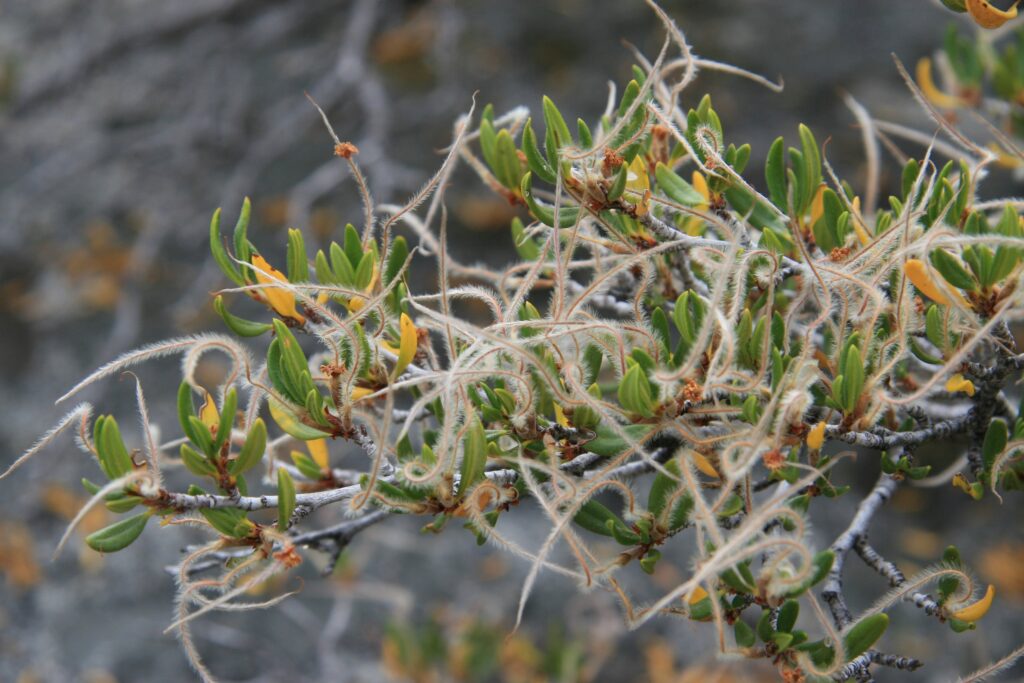
A long-lived, evergreen, multi-stemmed, woody shrub or small tree to fifteen feet. Has leathery, glossy dark green foliage and aromatic reddish-brown bark. Flowers are white, small and insignificant, appearing in early summer. Long, twisted, plume-tailed fruit comes in fall. Very drought tolerant.

Littleleaf Mountain Mahogany
Cercocarpus intricatus
Littleleaf mountain mahogany is a tough little shrub, tolerant of climatic extremes. The dense twiggy growth bears inconspicuous flowers that, by midsummer, mature into beautiful, feathery seed pods.
A native plant of the southwestern deserts, it is tolerant of very low water conditions once established.
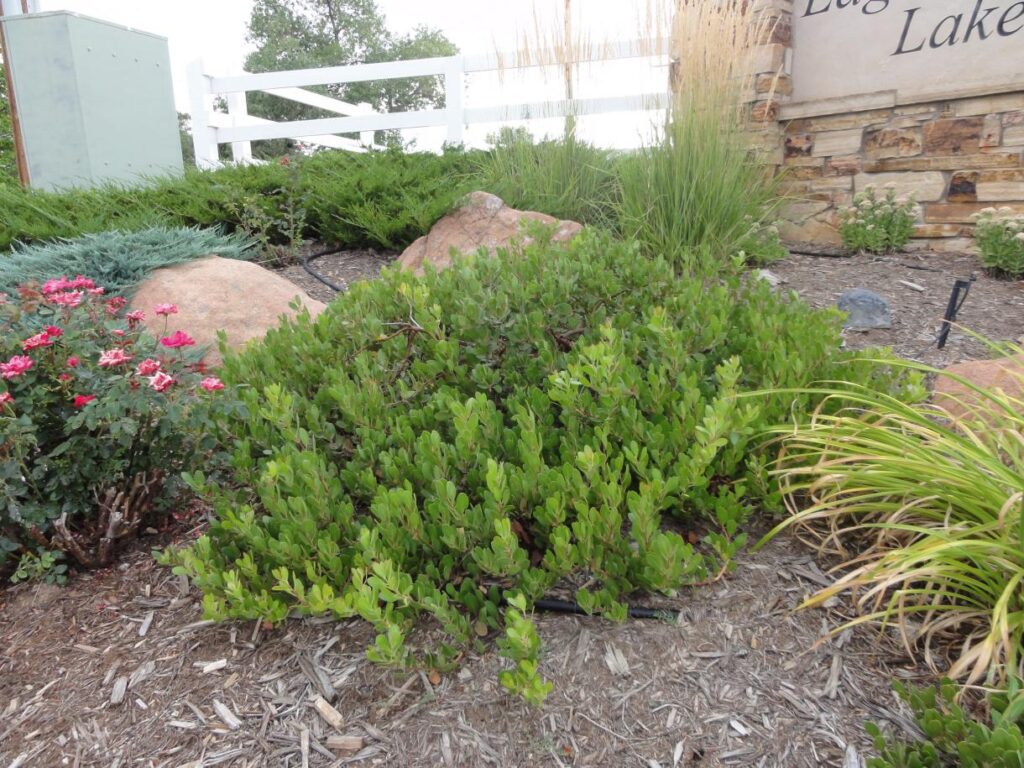
Chieftain Manzanita
Arctostaphylos x coloradoensis ‘Chieftain’
1.5’-3’ x 5’-8’
An Uncompaghre Plateau selection (The Uncompahgre Plateau in western Colorado is a distinctive large uplift part of the Colorado Plateau) that is a much more vigorous manzanita than both the “Panchito” and “Mock Bearberry” introductions. Oval leaves emerge with a reddish tint changing to bold dark green, persisting through the winter making this an outstanding evergreen groundcover. White flowers tinged with pink appear in late spring followed by red berries in early fall. Striking, smooth cinnamon-red to purplish exfoliating bark appears as the plant matures.

Mock Bearberry Manzanita
Arctostaphylos x coloradoensis ‘Mock’
6”-8” x 4’-6’
Outstanding selection of a native broadleaf evergreen shrub from the Uncompaghre Plateau. Waxy, urn-shaped, white flowers produce small red berries on established plants. Adapted to dry climate, mineral soils, fluctuating temperatures and high altitude winter sunshine, making them perfect choices for winter color and interest.

Panchito Manzanita
Arctostaphylos x coloradoensis ‘ Panchito’
1.5’ – 2’ x 2.5’-4
Outstanding selection of a native, broadleaf evergreen from the Uncompaghre Plateau in western Colorado. Tiny, waxy, white, urn-shaped flowers are very appealing. Small red berries can be produced on established plants.

Ocean Spray
Holodiscus discolor
Holodiscus discolor is a deciduous shrub that normally grows to 4-5 feet but can grow to 7feet. The 5 inch long flower clusters are cream colored and fragrant from May-July. The flowers are edible and have a noticeable scent that is very sweet.

New Mexico Privet
Forestiera neomexicana
Fast growing deciduous shrub with green to gray-green foliage. Inconspicuous yellow-white flowers bloom in spring followed by small black berries enjoyed by birds. Shape improves with age. Useful fast filler for desert conditions. Drought tolerant after established. Prefers alkaline soil and tolerates many different soil textures.

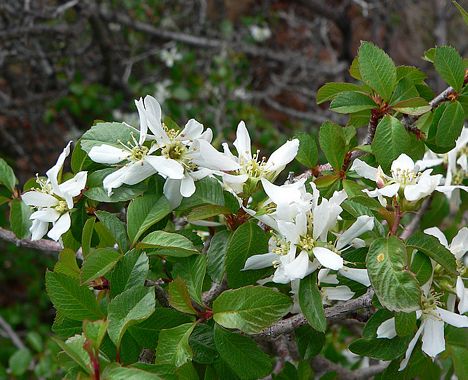
Utah Serviceberry
Amelanchier utahensis
The Utah serviceberry, is a shrub native to western North America. It grows in varied habitats, from scrubby open slopes to woodlands and forests. It is a spreading plant, reaching a maximum of 15 feet in height. In April and May the shrub blooms in short flower clusters of white flowers. The Utah serviceberry is eagerly browsed by desert bighorns, elk, and mule deer, as well as many birds and domesticated livestock.
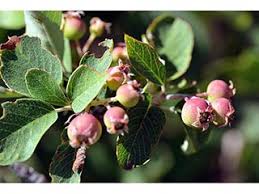

Siberian Peashrub
Caragana arborescens
The Siberian pea tree is a large, rounded, multi-stemmed, deciduous shrub with upright branching that grows to 15-20′ tall and to 12-15′ wide. It is native to Siberia and Manchuria.


Globe Peashrub
Caragana arborescens ‘Globosa’
A very small, dense shrub that makes an excellent foundation plant; it produces the freshest green leaves in spring with yellow flowers, and small seed pods in August.

Walker Weeping Siberian Pea
Caragana arborescens ‘Walker’
Walker’s weeping peashrub is a cultivar that has to be grafted into a particular shape. … The result is a unique and remarkably uniform weeping shape as the stems grow out from the trunk and then straight down to the ground.
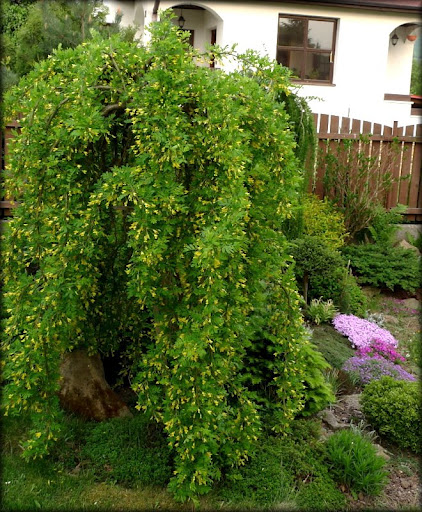
Weeping Siberian Pea
Caragana arborescens ‘Pendula’
The weeping Siberian pea shrub is generally used as an accent plant because of its stiffly arching branches. It can grow to a height of about 10 feet with full sun and moderate moisture conditions. In late spring it produces yellow flowers that give way to brown fruit in the summer.


Fruitland Silverberry

Elaeagnus pungens ‘Fruitlandii’
A large tough dense evergreen shrub that can grow rapidly to 6 to 10 feet tall and wide but often is kept smaller. It has angular branches bearing large leaves that are silvery in new growth and mature to an olive green color dotted with silver scales on the upper surface and solid silver-dotted with brown scales beneath. Fragrant, small creamy-white flowers in pendant cluster appear in the fall followed by brownish red fruit. Can be grown in full sun to light shade with moderate to low irrigation and is seaside tolerant. Although a plant native to coastal regions in Japan and China it is notable that this plant can tolerate nearly any condition from the beach to high and low deserts where aridity, wind, poor soils, high heat and relatively low temperatures do not faze it. Makes a great large screen or hedge plant and foliage is useful in fall flower arrangements.
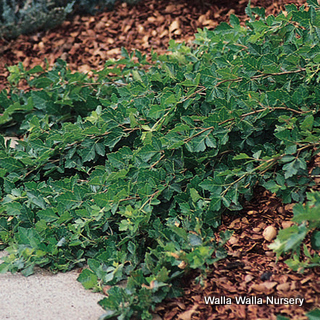
Autumn Amber Sumac
Rhus trilobata ‘Autumn Amber’
Height: 10”-14”
Width: 6’-8’
Perfect ground cover shrub with attractive foliage and low maintenance for sunny, wide open spaces. Softens the hardscape of terraced walls and rock features and brings a naturalized look to the landscape. Once established, Autumn Amber will cover sizeable space, so it is a good choice for larger landscapes. Fall color will vary from yellow to deep amber.

Cutleaf Staghorn Sumac
Rhus typhina ‘Laciniata’
Staghorn sumac has fuzzy fruit and stems and is named “staghorn” because the fuzzy fruit spike resembles a stag’s horn in velvet.

Gro-Low Fragrant Sumac
Rhus aromatica ‘Gro-Low’
Grows 2 to 3 feet tall with a 6 to 8 foot spread. This popular Midwest cultivar has aromatic green leaves which turn a red-orange in the fall. Ideal as a ground cover or in mass, and is an excellent shrub to stabilize on banks and slopes.


Lacette Fragrant Sumac
Rhus aromatica ‘Lacette’
Compact growing, yet more refined than ‘Gro Low’, which is the market standard, Lacette adds a graceful elegance to difficult landscape sites. Lacy in appearance, but denser in habit, its small leaves are aromatic when crushed and half the size of others in commerce.

Skunkbush Sumac (Three-Leaf)
Rhus trilobata
Height: 4-8′ Spread: 4-5′
Three leaf sumac is a tough colorful native shrub with chartreuse spring flowers, red summer ripening fruit and colorful fall foliage in shades of yellow, orange and red. Drought resistant/drought tolerant plant.
Smooth Sumac
Rhus glabra
The colony-forming smooth sumac is a 10-20 ft. shrub with short, crooked, leaning trunks and picturesque branches. The pinnately compound leaves are alternate with 13-30 sharp-toothed leaflets on each side of the midrib. Deciduous leaves become extremely colorful in early fall. On female plants, yellow-green flowers are followed by bright-red, hairy berries in erect, pyramidal clusters which persist throughout winter.




Tiger Eyes Cutleaf Staghorn Sumac
Rhus typhina ‘Bailtiger’
Tiger Eyes® is a beautiful golden-leafed form of cutleaf staghorn sumac. New growth is a lively chartreuse green, quickly changing to yellow with both colors contrasting nicely with the rosy-pink leaf stems. The branches angle upward while the deeply cut leaflets drape downward. As magnificent as the summer colors are, the dramatic effect of yellow, orange and intense scarlet in autumn are unparalleled. This showy plant can be used as an accent or in mass plantings. It tolerates a wide range of soils as well as urban conditions, and is adaptable to poorly drained soils as well as very dry soil.

Adam’s Needle Yucca
Yucca filamentosa
This yucca is a plant in the agave family that is often used in Southwest themed landscapes, even though it is native to the Southeast U.S
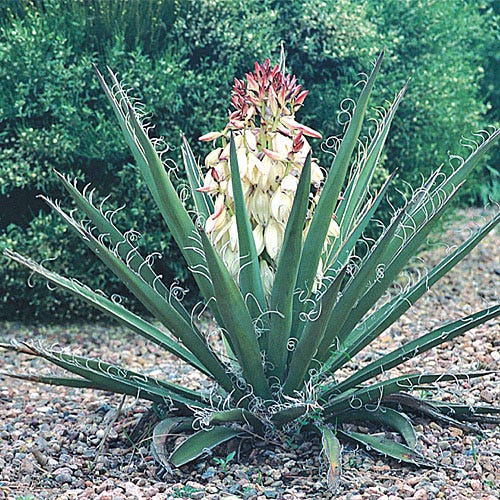
Banana Yucca
Yucca baccata
Banana yucca is one of about 40 yucca species, all of which are native to the New World. Most yuccas have dry hard fruits, but the fruits of banana yucca are fleshy and succulent. They look roughly like short fat green bananas, thus the name. These fruits were a traditional food of the Apache and Navajo.

Blue Sentry Yucca
Yucca rigida ‘Blue Sentry’
‘Blue Sentry’ has striking blue needled new growth, fading to powder blue, with a narrow yellow margin. Slow upright habit, to 10+’ with age. more often 4 to 5′. With some maturity, a beautiful 5’ -6’ stalk of creamy white bell flowers appear above the needles.
Does best in full sun, alkaline, well drained soils, but is tolerant of most conditions.

Blue Beaked Yucca
Yucca rostrata
A slow-growing tree-like yucca with upright stems and beautiful gray-blue narrow foliage. Although it can branch, it is most often seen with a single trunk, that can grow to 12-15 feet tall. The 2 foot long, stiff, slightly waxy, pale bluish-green leaves with yellow margins, form a dense rosette on top of the stems. The old leaves fall off leaving a fibrous soft gray covering on the trunk. Large clusters of white flowers bloom on yellow-orange colored stalks that rise above the foliage on mature plants in late spring. It performs best in warm sunny areas with good drainage, occasional to infrequent summer irrigation, and alkaline conditions. This plant naturally inhabits western Texas and northern Mexico in the states of Chihuahua and Coahuila where is can be found on rocky slopes and ridges. The specific epithet ‘rostrata’ means “beaked” in reference to either the shape of the flower buds or appendages on the fruit.

Brakelights Red Yucca
Hesperaloe parviflora ‘Perpa’ PP #21,729
Height: 2′, Blooms 4-5′
Spread: 2′
Flowers are a much darker, truer red than the species. Compact growth habit with a very long bloom season. The selection is a little less vigorous and much slower growing.

Color Guard Yucca
Yucca filamentosa ‘Color Guard’
The Color Guard Yucca has a mounded growing habit. Its leaves are a creamy yellow with green edges in the spring and summer. The centers of this North American native take on a rose color in the fall. In early and midsummer tall stalks of up to four feet sprout from the center. These stalks produce cream colored bell blooms that dangle. The mature height for this plant is two to three feet with a spread of one to two feet. Uses include border planting, landscape planting, mass planting and as a focal point.

Golden Sword Yucca
Yucca filamentosa ‘Golden Sword’
This evergreen shrub forms a rosette of bold, arching, striped leaves, which are not as stiffly upright as those of its cousin, Yucca filamentosa. In “Agaves, Yuccas and Related Plants,” the authors (Mary and Gary Irish) note that yuccas provide “strong structural relief to perennial gardens and evergreen color to winter gardens.” The leaves of ‘Golden Sword’ have a central golden stripe with variable blue-green stripes along their margins. This shrub is very easy to grow, being drought and heat tolerant. It makes an outstanding container specimen.

Ivory Tower Yucca
Yucca filamentosa ‘Ivory Tower’
Height: 3-4′ Foliage, 6′ Blooms
Spread: 3-4′
A rosette of sword-like mounded green leaves are topped by tall spikes of green-tinged ivory white blooms. Forms dramatic clumps with age. Use to create contrasting textures as a garden accent or container specimen.

Joshua Tree Yucca
Yucca brevifolia
Joshua tree is a large, slow-growing, evergreen, tree form yucca native only to the Mojave Desert of the southwestern United States. It is found growing at elevations between 1,600-7,200′ on open, rocky grasslands where they visually dominate the landscape. Mature individuals usually reach around 15-30′ tall (sometimes to 50′ or more) with an open, rounded canopy of equal width. The average lifespan of a Joshua tree is estimated at 150 years. Younger plants lack the distinctive branching of older specimens. The stiff, narrow, tapered leaves have terminal spines and small serrations along the margins. The foliage forms rosettes on the ends of the branches, and desiccated leaves remain on the plant covering the trunk and stems. The creamy white, round to ovate flowers are borne on terminal panicles (up to 20″ long). Light green seedpods (up to 4″ long) mature on the tree in clusters. In their native habitat, Joshua trees are an important source of food and shelter for wildlife. Many birds utilize the branches for nesting and perching. A single moth species called the yucca moth pollinates the flowers. The specific epithet brevifolia means “short leaves”, in reference to the length of the foliage relative to other yuccas.
Height: 15-30′ Spread: 15-30′


Red Yucca
Hesperaloe parviflora
A stemless succulent with clumps of arching and spreading grass-like foliage to 3 to 4 feet tall and speading wider than tall. The leathery long, narrow blue-green leaves have deep grooves and white fraying fibers along the margins and winter temperatures sometimes turn the foliage slightly purple. Clumps spread slowly to up to 6 feet wide. In late spring to mid-summer the clusters of rose-pink flowers are borne on tall red flower stalks to 5 feet long, that arch up and outward.

Yellow Yucca
Hesperaloe parviflora ‘Yellow’
This form is typical of Hesperaloe parviflora in its 3-4′ rosettes and 5-6′ flower stalks but with canary yellow flowers. A very pretty and unusual selection and most attractive when combined in single plantings with the coral-orange flowered forms. Full sun to part shade with little summer water. Although it is closely related to yuccas, it is a member of the century plant family not the yucca family